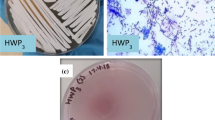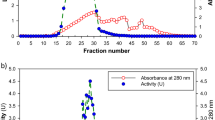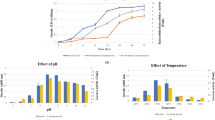Abstract
A new type of thermostable laccase was isolated from Paraphoma sp. GZS18, and its partial enzymatic properties were determined. A strain GZS18 of laccase with high yield was screened from forest soil and identified as Paraphoma sp. GZS18 through morphological characteristics and ITS sequence analysis. The laccase of Paraphoma sp. GZS18 (Lac-P) was obtained through cation–anion exchange chromatography, gel filtration chromatography, and other purification processes. The testing result shows that Lac-P is a single protein of 75 kDa, and the 11 amino acid sequences in the N-terminal are AXaVSVASREMT (Xa was the non-standard protein). The optimum temperature and optimum pH of lac-P activity are substrate-independent. The temperature is in the range of 50–70 °C, and pH has high catalytic efficiency in the acidic range. Lac-P has good stability in the temperature and pH. The half time at 70–60 °C is 1.5 and 4 h, respectively. At pH 6–9 and room temperature, there is more than 80% activity 24 h later. Lac-P is tolerant of most metal ions and low concentrations of inhibitors but is inhibited by Hg2+, Fe2+ and NaN3. The laccase from Paraphoma sp. GZS18 at high temperature and pH 6–9, with strong stability, has better industrial application characteristics.



Similar content being viewed by others
References
Ausec L, Črnigoj M, Šnajder M, Ulrih NP, Mandic-Mulec I (2015) Characterization of a novel high-pH-tolerant laccase-like multicopper oxidase and its sequence diversity in Thioalkalivibrio sp. Appl Microbiol Biotechnol 99:9987–9999
Autore F, Del Vecchio C, Fraternali F, Giardina P, Sannia G, Faraco V (2009) Molecular determinants of peculiar properties of a Pleurotus ostreatus laccase: analysis by site-directed mutagenesis. Enzyme Microb Technol 45:507–513
Aveskamp MM, Gruyter J, Woudenberg JHC, Verkley GJM, Crous PW (2010) Highlights of the Didymellaceae: a polyphasic approach to characterise Phoma and related pleosporalean genera. Stud Mycol 65:1–60
Campos PA, Levin LN, Wirth SA (2016) Heterologous production, characterization and dye decolorization ability of a novel thermostable laccase isoenzyme from Trametes trogii BAFC 463. Process Biochem 51:895–903
Chernykh A, Myasoedova N, Kolomytseva M, Ferraroni M, Briganti F, Scozzafava A, Golovleva L (2008) Laccase isoforms with unusual properties from the basidiomycete Steccherinum ochraceum strain 1833. J Appl Microbiol 105:2065–2075
Du W, Sun C, Yu J, Liang J, Liang Z, Han Y, Zou X (2012) Effect of synergistic inducement on the production of laccase by a novel Shiraia bambusicola strain GZ11K2. Appl Biochem Biotechnol 168:2376–2386
Du W, Sun C, Liang J, Han Y, Yu J, Liang Z (2015) Improvement of laccase production and its characterization by mutagenesis. J Food Biochem 39:101–108
Ebrahimpour A, Rahman RNZRA, Basri M, Salleh AB (2011) High level expression and characterization of a novel thermostable, organic solvent tolerant, 1,3-regioselective lipase from Geobacillus sp. strain ARM. Bioresour Technol 102:6972–6981
Edens WA, Goins TQ, Dooley D, Henson JM (1999) Purification and characterization of a secreted laccase of Gaeumannomyces graminis var. Tritici. Appl Environ Microbiol 65:3071–3074
Elisashvili V, Kachlishvili E, Khardziani T, Agathos SN (2010) Effect of aromatic compounds on the production of laccase and manganese peroxidase by white-rot basidiomycetes. J Ind Microbiol Biotechnol 37:1091–1096
Farver O, Wherland S, Koroleva O, Loginov DS, Pecht I (2011) Intramolecular electron transfer in laccases. FEBS J 278:3463–3471
Forootanfar H, Faramarzi MA, Shahverdi AR, Yazdi MT (2011) Purification and biochemical characterization of extracellular laccase from the ascomycete Paraconiothyrium variabile. Bioresour Technol 102:1808–1814
Garg N, Bieler N, Kenzom T, Chhabra M, Ansorge-Schumacher M, Mishra S (2012) Cloning, sequence analysis, expression of Cyathus bulleri laccase in Pichia pastoris and characterization of recombinant laccase. BMC Biotechnol 12:75
Halaburgia VM, Sharmab S, Sinhab M, Singhb TP, Karegoudara TB (2011) Purification and characterization of a thermostable laccase from the ascomycetes Cladosporium cladosporioides and its applications. Process Biochem 46:1146–1152
Hofmann U, Schlosser D (2016) Biochemical and physicochemical processes contributing to the removal of endocrine-disrupting chemicals and pharmaceuticals by the aquatic ascomycete Phoma sp. UHH 5-1-03. Appl Microbiol Biotechnol 100:2381–2399
Hsu CA, Wen TN, Su YC, Jiang ZB, Chen CW, Shyur LF (2012) Biological degradation of anthroquinone and azo dyes by a novel laccase from Lentinus sp. Environ Sci Technol 46:5109–5117
Iracheta-Cárdenas MM, Rocha-Peña MA, Galán-Wong LJ, Arévalo-Niño K, Tovar-Herrera OE (2016) A Pycnoporus sanguineus laccase for denim bleaching and its comparison with an enzymatic commercial formulation. J Environ Manage 177:93–100
Junghanns C, Parra R, Keshavarz T, Schlosser D (2008) Towards higher laccase activities produced by aquatic Ascomycetous fungi through combination of elicitors and an alternative substrate. Eng Life Sci 8:277–285
Junghanns C, Pecyna MJ, Böhm D, Jehmlich N, Martin C, von Bergen M, Schauer F, Hofrichter M, Schlosser D (2009) Biochemical and molecular genetic characterisation of a novel laccase produced by the aquatic ascomycete Phoma sp. UHH 5-1-03. Appl Microbiol Biotechnol 84:1095–1105
Lee KM, Kalyani D, Tiwari MK, Kim TS, Dhiman SS, Lee JK, Kim IW (2012) Enhanced enzymatic hydrolysis of rice straw by removal of phenolic compounds using a novel laccase from yeast Yarrowia lipolytica. Bioresour Technol 123:636–645
Levasseur A, Saloheimo M, Navarro D, Andberg M, Pontarotti P, Kruus K, Eric Record (2009) Exploring laccase-like multicopper oxidase genes from the ascomycete Trichoderma reesei: a functional, phylogenetic and evolutionary study. BMC Biochem 11:1–10
Liang JD, Han YF, Zhang JW, Du W, Liang ZQ, Li ZZ (2011) Optimal culture conditions for keratinase production by a novel thermophilic Myceliophthora thermophila strain GZUIFR-H49-1. J Appl Microbiol 110:871–880
Liu J (2013) Laccase production by Pycnoporus sp. SYBC-L3 and its applications. [Doctoral dissertation]. Jiangnan University. Wuxi, China, 3–12
Liu Z, Zhang D, Hua Z, Li J, Du G, Chen J (2009) A newly isolated Paecilomyces sp. WSH-L07 for laccase production: isolation, identification, and production enhancement by complex inducement. J Ind Microbiol Biotechnol 36:1315–1321
Liu J, Jiao G, You X, Liao X, Sun L (2016) A review on properties, production, and application of fungal laccases. Biotechnol Bull 32:24–33
Liu Y, Huang L, Guo W, Jia L, Fu Y, Gui S, Lu F (2017) Cloning, expression, and characterization of a thermostable and pH-stable laccase from Klebsiella pneumoniae and its application to dye decolorization. Process Biochem 53:125–134
Neifar M, Jaouani A, Ellouze-Ghorbel R, Ellouze-Chaabouni S (2010) Purification, characterization and decolourization ability of Fomes fomentarius laccase produced in solid medium. J Mol Cat B: Enz 64:68–74
Othman AM, Elshafei AM, Hassan MM, Haroun BM, Elsayed MA, Farrag AA (2014) Purification, biochemical characterization and applications of Pleurotus ostreatus ARC280 laccase. Br Microbiol Res J 4:1418–1439
Park N, Park SS (2014) Purification and characterization of a novel laccase from Fomitopsis pinicola mycelia. Int J Biol Macromol 70:583–589
Park M, Kim M, Kim S, Ha B, Ro HS (2015) Differential expression of laccase genes in Pleurotus ostreatus and biochemical characterization of laccase isozymes produced in Pichia pastoris. Mycobiology 43:280–287
Prins A, Kleinsmidt L, Khan N, Kirby B, Kudanga T, Vollmer J, Pleiss J, Burton S, Le Roes-Hill M (2015) The effect of mutations near the T1 copper site on the biochemical characteristics of the small laccase from Streptomyces coelicolor A3(2). Enzyme Microb Technol 68:23–32
Sadhasivam S, Savitha S, Swaminathan K, Lin FH (2008) Production, purification and characterization of mid-redox potential laccase from a newly isolated Trichoderma harzianum WL1. Process Biochem 43:736–742
Solé M, Muller I, Pecyna MJ, Fetzer I, Harms H, Schlosser D (2012) Differential regulation by organic compounds and heavy metals of multiple laccase genes in the aquatic hyphomycete Clavariopsis aquatica. Appl Environ Microbiol 78:4732–4739
Tinoco R, Acevedo A, Galindo E, Serrano-Carreon L (2011) Increasing Pleurotus ostreatus laccase production by culture medium optimization and copper/lignin synergistic induction. J Ind Microbiol Biotechnol 38:531–540
Yan J, Chen Y, Niu J, Chen D, Chagan I (2015) Laccase produced by a thermotolerant strain of Trametes trogii LK13. Brazilian J Microbiol 46:59–65
Yang Y, Ding Y, Liao X, Cai Y (2013) Purification and characterization of a new laccase from Shiraia sp.SUPER-H168. Process Biochem 48:351–357
Yang J, Lin Q, Ng TB, Ye X, Lin J (2014) Purification and characterization of a novel laccase from Cerrena sp. HYB07 with dye decolorizing ability. PLoS ONE 9:e110834
Yang J, Wang G, Ng TB, Lin J, Ye X (2015a) Laccase production and differential transcription of laccase genes in Cerrena sp. in response to metal ions, aromatic compounds, and nutrients. Front Microbiol 6:123–128
Yang J, Zou YJ, Zhang RY, Hu QX (2015b) Purification and property of laccase from Pleurotus eryngii var. tuoliensis. Mycosystema 34:456–464
Acknowledgements
This work was financially supported by the Science technology Program of traditional Chinese medicine and minority medicine in Guizhou Province of traditional Chinese medicine Administration (No. QZYY-2014-028); the Doctor Foundation of Binzhou University (Nos. 2016Y02 and 2016Y17); and the Natural Science Foundation of Shandong Province (Nos. ZR2016CL01 and ZR2016BL16).
Author information
Authors and Affiliations
Corresponding author
Ethics declarations
Conflict of interest
The author(s) declare(s) that there is no conflict of interest regarding the publication of this article.
Rights and permissions
About this article
Cite this article
Du, W., Sun, C., Wang, J. et al. Isolation, identification of a laccase-producing fungal strain and enzymatic properties of the laccase. 3 Biotech 8, 137 (2018). https://doi.org/10.1007/s13205-018-1149-7
Received:
Accepted:
Published:
DOI: https://doi.org/10.1007/s13205-018-1149-7




